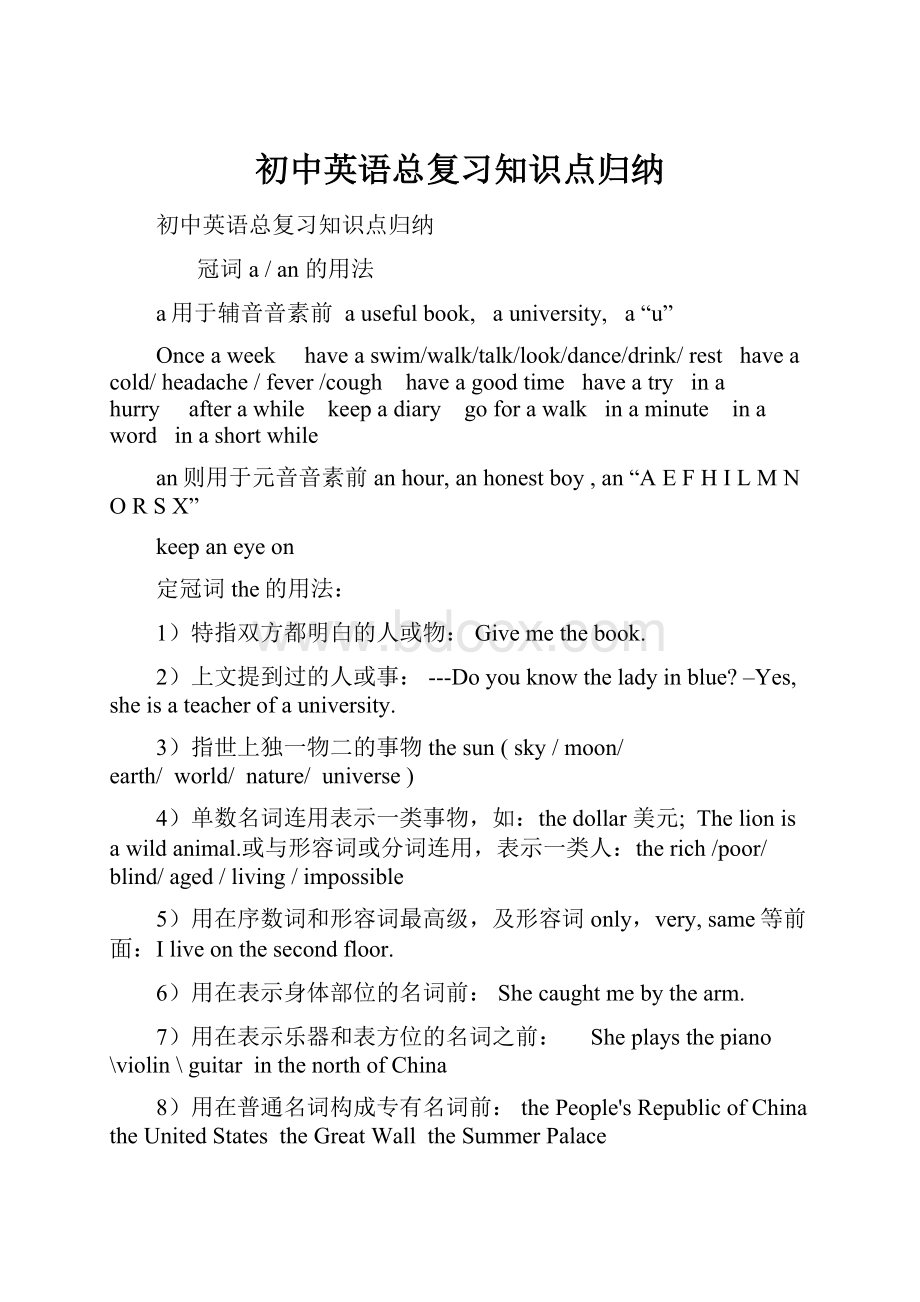初中英语总复习知识点归纳.docx
《初中英语总复习知识点归纳.docx》由会员分享,可在线阅读,更多相关《初中英语总复习知识点归纳.docx(24页珍藏版)》请在冰豆网上搜索。

初中英语总复习知识点归纳
初中英语总复习知识点归纳
冠词a/an的用法
a用于辅音音素前 ausefulbook, auniversity, a“u”
Onceaweek haveaswim/walk/talk/look/dance/drink/rest haveacold/headache/fever/cough haveagoodtime haveatry inahurry afterawhile keepadiary goforawalk inaminute inaword inashortwhile
an则用于元音音素前anhour,anhonestboy,an“AEFHILMNORSX”
keepaneyeon
定冠词the的用法:
1)特指双方都明白的人或物:
Givemethebook.
2)上文提到过的人或事:
---Doyouknowtheladyinblue?
–Yes,sheisateacherofauniversity.
3)指世上独一物二的事物thesun(sky/moon/earth/ world/ nature/ universe)
4)单数名词连用表示一类事物,如:
thedollar美元; Thelionisawildanimal.或与形容词或分词连用,表示一类人:
therich/poor/blind/aged/living/impossible
5)用在序数词和形容词最高级,及形容词only,very,same等前面:
Iliveonthesecondfloor.
6)用在表示身体部位的名词前:
Shecaughtmebythearm.
7)用在表示乐器和表方位的名词之前:
Sheplaysthepiano\violin\guitar inthenorthofChina
8)用在普通名词构成专有名词前:
thePeople'sRepublicofChina theUnitedStates theGreatWall theSummerPalace
9)用在姓氏的复数名词之前,表示一家人:
theGreensareplayingthepiano.
10)intheday,inthemorning(afternoon,evening), inthemiddle(of), intheend, allthetime atthesametime onthewhole, bytheway, gotothecinema atheageofsix atthebeginningofthetwenty-firstcentury ontheothersideof atthemoment thedayaftertomorrow thedaybeforeyesterday, thenextmorning, inthesky(water,field,country) inthedark,intherain,
不用定冠词的情况
1)国名,人名前通常不用定冠词:
China,Europe 欧洲LeiFeng雷锋
2)物质名词和抽象名词表示一般概念时,通常不加冠词;当表示特定的意思时,需要加定冠词Failureisthemotherofsuccess. 失败乃成功之母。
3)在季节、月份、节日、假日、日期、星期等表示时间的名词之前,不加冠词;Children’sDay Mother’sDay Father’sDay
4)在称呼或表示官衔,职位的名词前不加冠词;Heiscaptainoftheteam.
5)在三餐、四季,球类运动、学科、娱乐运动的名称前,不加冠词如:
havebreakfast/supper/lunch,playbasketball/football/volleyball/chess,inspring/summer/autumn/winter
6)当by与火车等交通工具连用,表示一种方式时,中间无冠词;bybus/train/taxi/bus/ship
7)Dayandnight facetoface sidebyside stepbystep watchTV atschool/work/home atfirst/last indanger introuble onfoot onduty onwatch inbed ontime intime gotoschool gotowork bytaxi/bike atnoon atnight onTV attown
部分词组有无冠词的区别
inhospital生病住院inthehospital在医院里
infrontof在---的前面inthefrontof在----内部的前面
gotoschool上学gototheschool到学校去
anumberof=alotof许多,谓语动词用复数。
Thenumberof----的数目,----的总数,谓语动词用单数(第三人称单数)
名词:
专有名词和普通名词(个体名词、集体名词、物质名词、抽象名词)
可数名词的单数变复数①一般情况加s ②以s,xshch,等结尾的词加-es bus-buses watch-watches ③以o结尾的名词,无生命的加s,如:
photo---photospiano---pianos有生命的es,如:
potato--potatoes tomato--tomatoes 均可,如:
zero---zeros/zeroes ④以f或fe结尾的名词,去f,fe加ves,如:
half---halves knife---knives leaf---leaves wolf---wolveswife---wives life---lives thief---thieves(加s,如:
belief---beliefs roof---roofssafe---safes gulf---gulfs;)⑤以辅音字母+y结尾的词,变y为i,再加es baby---babies ⑥不规则:
a.单复数形式一样。
Sheep,deer,Chinese,Japanese.People,police,scissors,trousers b.其他的。
foot—feet tooth---teeth child—childrenmouse---miceman---menwoman---women businessman---businessmen
German---Germans womendoctors
集体名词:
People,police,(一般表示一个整体,谓用复数)class,family,glasses
不可数名词:
常见的不可数名词有:
information,news,room(空间),work,work,weather,advice,bread,food,milk,tea,ice,glasses,meat
① Alittle,abitof,some,much,alotof,quitealotof常修饰不可数名词.
② 不可数名词作主语,谓语动词用单数。
③ 如果用and连接两个不可数名词作主语时,谓语动词用复数。
Timeandmoneyare-
④ A cup\ glass \bottle \box \kilo \ group \crowd \class\ pair of
Twoandahalfkilosof=twokilosandahalfof
名词所有格 在英语中有些名词可以加"'s"来表示所有关系,带这种词尾的名词形式称为该名词的所有格,如:
ateacher'sbook。
名词所有格的规则如下:
1)单数名词词尾加"'s",复数名词词尾没有s,也要加" 's ",如theboy'sbag,men'sroom Children’sDay Mother’sDay Father’sDay
2)若名词已有复数词尾-s,只加" ' ",如:
Teachers’Day ladies’room twentyminutes’walk
3)凡不能加"'s"的名词,都可以用"名词+of+名词"的结构来表示所有关系,如:
thetitleofthesong歌的名字;Apictureoffamily;amapofChina
4)在表示店铺或教堂的名字或某人的家时,名词所有格的后面常常不出现它所修饰的名词,如:
thebarber's理发店。
5)如果两个名词并列,并且分别有's,则表示"分别有";只有一个's,则表示'共有'。
John'sandMary'sroom(两间) JohnandMary'sroom(一间)
6)复合名词或短语,'s加在最后一个词的词尾。
如:
amonthortwo'sabsence
7)双重所有格 afriendofmine/hers/his/theirs afriendofMary’smother’s
代词
1、人称代词、物主代词和反身代词
I—me—my—mine—myself you—you—your—yourself(yourselves)
he—him—his—his—himself she—her—her—hers—herself
it—it—its—its—itself we—us—our—ours—ourselves
they—them—their—theirs—themselves
人称顺序you,he,she,I; we,you,they
主格作主语;宾格作宾语,动词和介词之后通常作宾格;形容词性物主代词不能单独使用,通常放在名词之前;名词性物主代词=形容词性物主代词+名词,“of+名词性物主代词”表示所属关系。
Afriendofmine我的一位朋友;teacherofhers 她的老师
代词it的用法:
①指代前面提到过的事物。
②表天气。
③表距离。
④指婴儿和不明身份的人。
---John,someoneinyourclassphonedyouthismorning.---Oh,whowasit?
⑤用作形式主语。
It’skind/good/nice/clever/polite/foolishofsb.todosth.
It’simportant/necessary/possible/easy/difficultforsbtodosth,
It’stimetogetup.
It’stimeforlunch.
It’sone’sturntodo
Itseemsthat
Ittakessb.sometimetodosth.
⑥用作形式宾语。
Find/think/feel+it+adj+todosth
Itone的区别
It特指上文提到的同一对象,同一事物。
one同类而不同一。
that常用于比较结构中,代替前面提到的名词,以避免重复。
反身代词
构成规则:
一、二物主,三为宾。
运用:
hurt/teach/wash/buy/enjoyoneself
by/Helponeself(oneselves)to---/Lookafteroneself /Saytooneself /Cometooneself
2、不定代词little,alittle,few,afew=several(some),some,anymuch,toomuch,muchtoo,morethen=over,lessthan=nearly
something某事,某物,用于肯定句。
注意:
⑴由复合不定代词作主语时,谓语动词用第三人称单数。
Everyoneishere.
⑵修饰不定代词的形容词后置。
Ihavesomethingimportanttotellyou.
⑶在反意疑问句中,表示人的复合代词在陈述句中作主语时,附加问句中的主语用he或they,表物的用it。
anything任何事物,某事物,用于否定句、疑问句。
everything每件事,一切事物,用于各种句型。
nothing没什么,没有任何东西。
=not----anything
somebody某人,有人=someone
anybody任何人(用于否定句、疑问句,条件从句中)
nobody没有人
little,几乎没有,表示否定意思,用以修饰不可数名词。
Alittle ①一点点,表示肯定,用以修饰不可数名词。
Onlyalittle仅一点点.②也可修饰形容词和副词。
③一点点,放在动词、动词宾语后。
few几乎没有,表示否定意思,用以修饰可数名词。
afew=several几个,一些,表示肯定意思,用以修饰可数名词。
some 一些,修饰可数名词,后跟复数形式名词或ones,也可修饰不可数名词。
在表示请求、委婉语气的疑问句和表示希望得到对方的肯定回答的问句中,常用some.Couldyougivemesomeapples?
any一些,任何一些。
一般用于疑问句中或否定句中和IF引导的条件句中。
much许多。
修饰不可数名词,放在不可数名词前,可用alotof替换。
toomuch太多的,用法相当于much,放在不可数名词前。
Heathisveryimportanttous.Weshouldeatmorevegetablesandfruitinsteadoftoomuchrichfood.
muchtoo太,用法相当于too,放在形容词和副词前。
Keepquiet!
It’smuchtoonoisyhere.
morethan超过,多于。
=over
moreorless或多或少,差不多。
=about
atleast至少
alot许多,修饰动词。
Thanksalot.
alotof=lotsof许多的,可修饰可数名词和不可数名词。
anumberof许多的,=many只用于修饰复数形式名词,放在可数名词复数前。
every用于三个或三个以上,着眼于整体。
后可跟数词。
词组有everytenminuets
each用于两个或两个以上,着眼于个体。
词组有eachof
either 两个中任何一个
either----or
both 两个都
both----and---
bothof---
neither两个中一个也没有 e.g. ---Doyouliketalkingwithyourfriendsonthetelephoneormobilephone?
---Neither,IenjoyusingQQ.
neither---nor---
any三个以上中任何一个
all三个以上中全部
none三个以上中一个也没有。
Noneof---中没有一个,表示三个或以上数目的人或物中没有一个,表否定,作主语时,谓语动词一般用单数。
others 表示“泛指”除自己外,别的人。
Some----,others-----
theother表示两个中的另一个。
One----,theother----
theothers表示特指的另一些。
another后跟单数名词。
表示泛指另一个人。
后跟带数词的复数名词,表示“再,还要”的意思。
other别的,另外的,一般后跟复数名词或ones,在other前可加some,many或数词,表示“几个,一些别的”
Suchatallbuilding suchanexcitingfootballmatch
somanypeople
eachother相互,彼此,指两个或两个物时。
oneanother相互,彼此,指三者或三者以上的彼此。
oneanother’s相互的,彼此的。
数词
表示数目多少或顺序多少的词叫数词,数词分为基数词和序数词。
表示数目多少的数词叫基数词;表示顺序的数词叫序数词。
一、基数词和序数词
1)基数词写法和读法:
①百位与十位,用and, 十位与个位,写时用“—”②先确定分节号,从右至左,每隔三位数是一个分节号。
③第一个分节号是千位thousand 4第二个分节号是千位million ⑤第三个分号节是十亿位billion. 1,234,567,892 onebilliontwohundredandthirty-fourmillionfivehundredandsixty-seventhousandeighthundredandninety-two
2)分数表示法构成:
分子基,分母序,分子大于1时,分母在序数词后加S:
1/2ahalf 1/3one-third;2/3 twothirds 3/4threequarters=threefourths 2-3/4twoandthreefourths
3)表示"年代",用in+the+数词复数;inthe1980s(20世纪80年代)
4)表某人几岁时:
in+物主代词+数词的复数形式inone’stwenties
5)HelivesinRom88. Oneplustwoisthree.Threetimesfiveisfifteen.
6)hundred,thousand,million等词前有具体的数字时,不能加S 如threehundreds这种说法是错误的
7)hundredsof thousandsof millionsof
8)a21-year-oldgirl threedaysandahalf=threeandahalfdays oneandahalfhours=onehourandahalf we’llhavetwoweeks’holiday(two-weekholiday)
9)(基数词变序数词的口诀)
一、二、三特别记,th从四以上记;怎么加很容易,八减t,九减e; f来把ve替,见y变ie;若是遇到几十几,变换个位就可以。
One-first two-second three-third five-fifth eight-eighth nine-ninthtwelve–twelfth thirteen-thirteenth fifteen-fifteenth eighteen-eighteenth twenty-twentiethtwenty-one---twenty-first thirty-thirtieth forty-fortieth fifty–fiftieth sixty-sixtieth seventy-seventieth eighty-eightieth ninety-ninetieth
序数词的缩写形式:
first---1st second---2nd thirty-first---31st
形容和副词
①修饰something,anything,everything,anybody等不定代词的形容词,形容词要放在不定代词之后。
IhaveSomethingimportanttotellyou.
②enough修饰形容词、副词时,enough要放在形容词和副词之后。
Farenough
③interesting,exciting,boring,amazing,surprising,moving主语为物。
Interested,excited,amazed,surprised,frightened,tired,pleased主语为人。
④Much,far,alot,alittle,even等后要用形容词或副词的比较级。
Ifellevenworsenow.
5.连系动词be,感官动词(look,smell,taste,sound,feel)三个变(get,become,turn,)keep后跟形容词.
⑥既可作形容词又可作副词的词有:
hard作形容词=difficult,作副词,放在work,rain等后,表努力地做。
well作形容词身体好;作副词,做得好。
long作形容词,表事物的长度,作副词,放在last,talk等后,表动作持续。
Fast作作形容,放在系动词后,作副词放在rain,makesth.等词后,表“做得快”。
High作形容词“山,海浪的高。
作副词,放在fly,jump等后表飞得高,跳得高。
⑦五、形容词变为副词①+ly useful,wide,strong②改y为i,再加ly healthy,heavy,happy,lucky,noisy,③good——well terrible---terribly probable---probably
⑧多数以ly结尾的词是副词。
但friendly,lonely,lovely,likely,daily,lively是形容词。
⑨ChinaislargerthananyothercountyinAsia.(同一范围内) Chinaislargerthananycountyin